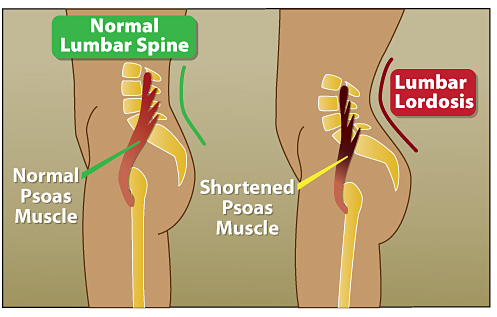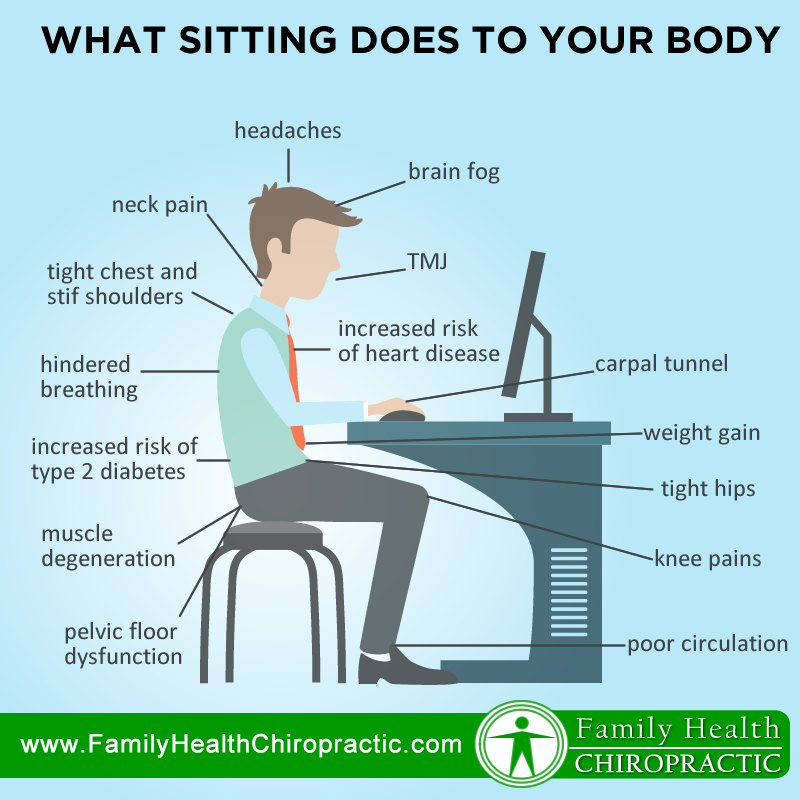“Don’t sit for too long, it’s bad for you”, “You’re going to get a bad back because you sit too much”, “get up and walk around during your work day”. I’m sure you’ve heard it all before; sitting is bad for you. Unfortunately, it seems that modern society has being built around sitting for a living, so avoiding it has become rather difficult.
We sit (North America) – on average – for 8-9 hours a day on top of 7-8 hours laying down to sleep at night. That’s one third of the day spent being inactive. We, as humans, were designed to move, so you can imagine what this lack of activity could be doing to our bodies both physically AND mentally.
What EXACTLY is sitting and inactivity doing to our bodies?
Head, Neck and Shoulders
Mohammed Taha, clinical director at Form Clinic, notes that it only takes a few minutes for someone to fall into a slouched position upon sitting down. This puts a lot of stress on your spinal ligaments and muscles that support your spine - this stress can lead to subluxations.
When you’re sitting at your desk on your computer, or sitting down doing homework, what do you find your head tends to do? Generally, when trying to concentrate our heads lean in closer to whatever we’re trying to focus on. This exaggerated forward lean will put the cervical spine (neck) in a non-optimal position. This puts a lot of stress on the spinal cord and spine, which can lead to dysfunction and permanent imbalances.
In this forward leaning position now, not only are you stressing the discs and joints in your spine and upper body, but also stressing the brain as well. When our bodies aren’t moving, our muscles are not pumping fresh blood and oxygen around the body as fast. Fresh, oxygenated blood helps trigger the release of brain- and mood- enhancing chemicals. No wonder you feel so drained after a long work day!
Core and Spine
An immobile spine becomes an inflexible spine. When the body is moving, so is the spine and the discs between the vertebrae. This movement allows the discs to get a fresh supply of blood and nutrients which helps them stay spongy – when the body is immobile for long periods of time day in and day out, those discs are less likely to be moving around and soaking up fresh blood, which means that over time, they will lose their spongyness and become unevenly squashed between the vertebrae.
The purpose of your core muscles is to hold your torso in an upright position, however if you’re slouching in a chair, they are not being called on to act how they are supposed to. In the long run, this causes weakening and degeneration due to the lack of stimulus. More specifically, your core will become weak – which if you read our previous blog post, you will know how important a strong core is for both injury prevention and improving overall quality of life.
Hips, Legs, and Feet
“Dead butt syndrome”, or “Dormant bottom syndrome”, although both sound like something your parents made up to scare you out of sitting all day, is a real phenomenon that personal trainers, physiotherapists, and kinesiologists are working to combat in patients every day. Gluteal Anemia – the more scientific name for dead butt syndrome – happens when the gluteus medius stops firing correctly. The gluteus medius is responsible for stabilizing the pelvis, so when “turned off” it can lead to lower back and hip pain, along with knee and ankle issues due to your body will be trying to compensate for the imbalances.
Andrew Bang, a Chiropractor at Cleveland Clinic’s Wellness Institute explains that “Dead butt syndrome has to do with reciprocal inhibition - a process that describes the give-and-take relationship between muscles on either side of a joint. In general, when one muscle contracts, a nerve signal is sent to its opposing muscle to relax. When you spend hours on end in a seated position, your hip flexors are contracting while your glutes rest. Over time, we’re basically training our glutes to be weak”. (health.com)
Not only that, but while in a seated position, our hip flexors are in a permanently shortened position which means that upon standing our low back will be compromised/stressed which will = more pain – not ideal!

As well as the lack of stress to the muscles involved (or not) in the seated position, there is also a significant lack of stress being put onto the bones of the lower body. Bones become more prone to things like osteoporosis when there is a lack of weight baring activities, especially if there is a lack of it through ones younger years. Weight baring activities put stress on the bones, which leads to them working to become stronger and denser. The only weight baring that sitting is doing is on your glutes – and we’re already discussed the negatives of inactive glutes!
Organs
Sedentary behaviour is often linked to more than 30 chronic diseases or conditions (healthline.com).
When the nerves leading to certain organs are choked off due to a misalignment, or there is not a steady, fresh supply of blood going to these organs, these organs start to degenerate and die. When sedentary, especially in a seated position, the nerves in the lower back especially are compromised, like we mentioned above. Circulation of blood throughout the body starts to slows down when immobile, which causes blood to pool in the legs; this is not ideal as fresh blood full of oxygen and nutrients is not being delivered to all the organs in the core. This lack of circulation and movement causes blood to pool in the legs which puts a large amount of stress on the veins of the lower body. This can lead to swollen ankles, varicose veins, or even worse, deep vein thrombosis (DVT).
This reduction in blood flow, paired with muscular inactivity, leads to a reduction in how much fat is being burned. The slow flow of blood through the heart means that fatty deposits are not pushed through the heart as efficiently, leading to a build-up. This can lead to high blood pressure, elevated cholesterol, and other cardiovascular diseases.
An over productive pancreas is also a big concern that comes from sitting all day. The pancreas produces insulin, which is a hormone that carries glucose to cells for energy. However, if muscles are inactive, their need for energy is not as high, so they don’t respond as well to the insulin. In response, the pancreas will produce more and more insulin in an attempt to get more to the muscles, which can lead to diabetes in the long run, as well as certain types of cancers.

As you can see, making a habit out of sitting all day is not ideal for the function and well-being of the body. Try and make a conscious effort to get up and move regularly throughout the day, as well as making physical activity part of your routine to ensure that your muscles are being called upon to move, your heart is being appropriately stressed, and your spinal column has the chance to move.

